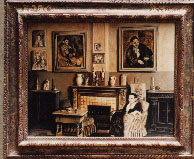Mirror, Mirror: The Strange Case of the Salon de Fleurus
Marcel Duchamp, beholding the flowering of the New York art scene, once said that “the great artist of tomorrow will go underground.” In at least one case, that prediction has proved truer than even the grand old trickster may have imagined.
click images to enlarge
- Figure 1
- Figure 2
- Salon de Fleurus
- Salon de Fleurus
- Figure 3
- Figure 4
- Painting at Salon
de Fleurus - Painting at Salon
de Fleurus
click to enlarge
Figure 5
Mike Bidlo, The
Fountain Drawings, 1998
The immediate effect is clear enough. Typically, the process of integrating art into the world begins with an advance broadcast of the artist’s personality, often a single memorable word (“insane,” “British,” “doctor,” etc.), which serves as a seed for all that follows. At the salon, this strategy of reductionism has reached its apogee: the viewer no longer knows whom to turn to for the expected explanation. Like the spherical caves in E.M. Forster’s A Passage To India, the Salon de Fleurus is perfectly self-contained, canceling out every echo with an opposing one, until one is essentially left with one’s own thoughts.
But why, and to what end? Ten years after the day I first sat in the salon and breathed the pungent scent of mothballs, I am in no better position than the average observer to answer this question. I still bring my own ideas to the space, pitting my forensic powers against hints and clues, with no hope of confirmation or denial. What follows are some of the thoughts I’ve accrued in the presence of this artistic sphinx.
First and foremost, it is not really correct to speak of the Salon de Fleurus as an art space. This may explain why so few have tried. It has been described as a curiosity, a recreation of Gertrude Stein’s storied salon, a sardonic comment on Modernism, a masterful reflection of the same, and more.
But whatever the analysis, it has mobilized no great hope for the rebirth of Cubism–and understandably so. The salon may be about art spaces, but that is not the same thing as being one.
In the strictest sense, we cannot even call the individual paintings art, just as we cannot know if prehistoric cave painters would have consented to today’s definition of the term. Indeed, the only time any objects from the salon have only been classified as such is when they have appeared outside their original context, as in their recent inclusion in the Whitney Biennial.
An Australian aborigine, seeing his dreamings in a plush uptown gallery, would certainly appreciate the paradox.
We have entered the realm of archeology, then, but of archeology of what? Having opened a fault line between image and word, the salon seems to demand a re-examination of art criticism, which has become increasingly reliant on personality to find its way. Perhaps, in referring to the most iconic of Modernist painters, it seeks more specifically to disassemble the story of Modernism, which has been selling so many T-shirts of late.
Of course, Picasso, Matisse, and Cezanne have been interpreted in such widely varying ways by now that the spectrum would seem to include all possible responses to anything. In this sense, the salon has benefited from its longevity. The varied attempts to explain its contents–as a hoax, as an experiment, as a subversive act–mirror the whole range of interpretations of 20th-century art. With each unconfirmed reading, the next prospect is trotted out, until the final exhaustion of Modernism is replayed.
click to enlarge
Figure 6
Painting at Salon
de Fleurus
That, perhaps, is a conclusion worth living with: where Duchamp introduced familiar objects as works of art (albeit in a magisterial act of misdirection), the Salon de Fleurus manages to cast familiar art works back to the unknown (Fig. 6). The structure of what we see is, if not shattered or exploded, at least rendered expertly tenuous, like a house with all of its nails removed.
At this stage in the game, it is worth asking whether such an intriguing project can ever bear offspring. Or rather, if it has, how would anyone know? With no one on hand to confirm or deny, anyone can lay claim to the salon as an influence–provided, among the infinite interpretations, he can discover what constitutes lineage. A space is open, waiting to be recognized and claimed, Should that come to pass, we can look forward to a growing body of work that is not only brilliant in its implications, but expansive as well.



